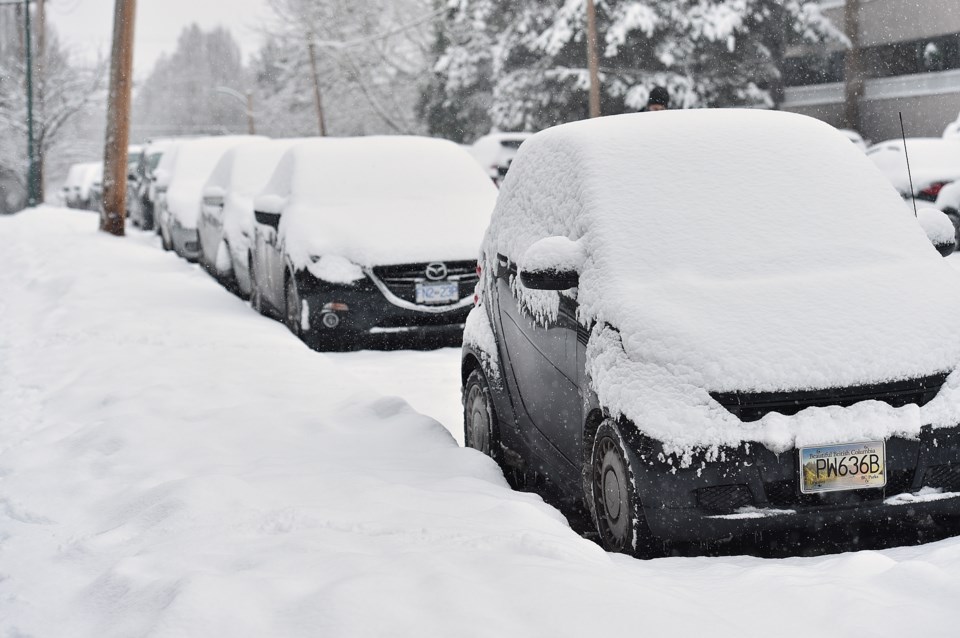With freezing temperatures and the possibility of between five and 10 centimetres of snow in the forecast, the city of Â鶹´«Ă˝Ół»wants residents to know it is ready.
In an information bulletin sent out Thursday morning, the city said crews have been out brining and salting “priority response locations” and are prepared to start salting and plowing roads if the forecasted flurries materialize
“The extent of snowfall accumulations in Â鶹´«Ă˝Ół»remains uncertain for tonight and over the next few days, but if required,” the bulletin reads.
If it snows, priorities for plowing include arterial roads, bus routes, bridges, emergency routes, school routes and priority bike lanes.
“We also prioritize bus stops, arterial corner ramps and pedestrian pathways along the seawall and Arbutus Greenway.”
The city also had some strong recommendations for drivers — take weather and road conditions into account, and use winter tires that display the three-peaked mountain and snowflakes symbol, or the mud and snow (M+S) symbol, with at least 3.5 millimetres of tread.
As always, residents and business owners are reminded that they play a big role in ensuring snow and ice doesn’t become hazardous, especially for those with mobility challenges.
All property owners and occupants must clear snow and ice from sidewalks around their property by 10 a.m. the morning after a snowfall, seven days a week.
“It’s important that snow is cleared promptly from walkways and sidewalks before it hardens to ice.”
Residents who are unable to clear the sidewalks around their property, and have no other alternatives, are encouraged to sign up for the city’s Snow Angel program, which connects volunteers with seniors and people with mobility issues to help clear their sidewalks following a snowfall.
Matt MacDonald, a meteorologist with Environment Canada, spoke to Â鶹´«Ă˝Ół» about what locals should expect over the coming week.Ěý
"We will be struggling to get up to 3°C over the next few days," MacDonald said. "But true arctic air will reach the coast on Sunday."
MacDonald reports that temperatures could dip as low as -10°C Monday, with a chilly daytime high of -1°C. Further, blustery windsĚýwill make temperaturesĚýfeel decidedly colder.Ěý
"Monday and Tuesday will see some strong easterly winds move through the Fraser Valley," he explains.
MacDonald adds that blustery 40 km/h winds can make -9°C or -10°C temperatures feel as cold asĚý-20.
With temperatures expected to dip into that sub-zero territory in the coming days, the city is also planning on opening warming centres and additional shelter spaces for people sleeping outside.
Powell Street Gateway, which is next to Oppenheimer Park, is already open and will remain open every night until Jan. 15.
Warming centre locations include:
Ěý
|
Jan. 12 - 14 |
Britannia Community Centre (Hours: 9 p.m. to 8:30 am) Â鶹´«Ă˝Ół»Aquatic Centre (Hours: 10 p.m. to 6 a.m.) Overdose Prevention Society (Hours: 11 p.m. to 8 a.m.) |
|
Jan. 15 |
Britannia Community Centre (Hours: 9 p.m. to 8:30 a.m.) Overdose Prevention Society (Hours: 11 p.m. to 8 a.m.) |
Ěý
According to the city, since the start of winter weather, warming centres have been open on 22 nights and have been visited 2,597 times.
All are welcome and people can bring their carts and pets. People with their own bedding may choose to sleep at the centres and hot drinks and snacks are available.
The city’s extreme weather response shelters will also remain open until Jan. 15.
PLEASE SHARE: Due to cold weather, Powell Street Getaway will be open as a warming centre from tonight until January 15, along with EWR shelters across . If you need to stay warm, you will be welcomed at one of these locations. For details, see tables below:
— City of Â鶹´«Ă˝Ół»(@CityofVancouver)
Transit plan
With the likelihood of rain overnight and snow in the early morning hours, TransLink is readying for a potentially messy morning commute.
“This sequence of precipitation will not allow for early salting and sanding as the materials will wash away before snow hits,” the transit authority said in a press release. “We are encouraging customers to dress for the elements and use proper footwear to avoid slips and falls.”
In anticipation of snow, TransLink says it is:
- Calling in extra staff to assist customers and coordinate service.
- Coordinating with municipalities on snow clearing if priority routes are impacted.
- Coupling Millennium Line trains into four-car configurations to increase capacity while SkyTrain attendants monitor guideways.
- Deploying special trucks to spread anti-icing solution on trolley wires.
- Stalling brass “cutters” on some trolley buses to cut through ice on trolley wires.
If conditions are severe, TransLink says it will:
- Replace articulated buses with 40-foot conventional buses when necessary, as they are more agile on steep, slippery areas.
- Install tire socks on buses on Burnaby Mountain and on key North Shore routes where hills and traction are an issue.
- Position attendants at the front of each Expo and Millennium Lines train to improve reliability on the system by limiting emergency braking triggered by heavy snowfall.
- Run a special SkyTrain that sprays de-icer on the power rail to keep trains moving.
- Run trains through the night if snow is especially heavy, to keep tracks clear.
- Send HandyDART out with two staff per vehicle, to ensure customers get safely to their door, and assist in digging out the bus if required.
- Activate further staff increases to assist customers right across the system.



